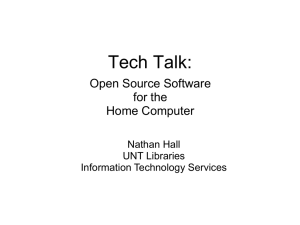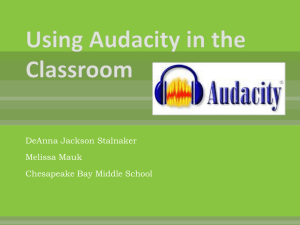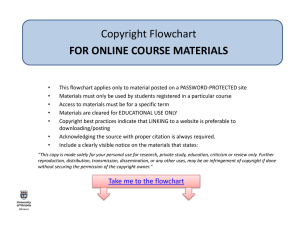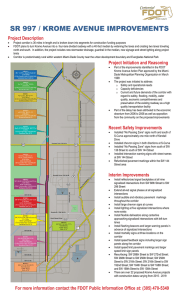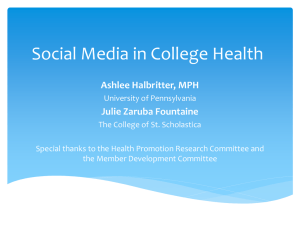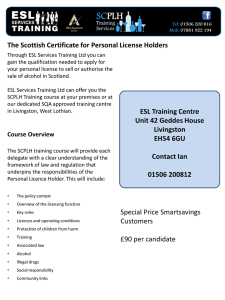Open Source Software Tools for Law Libraries
advertisement
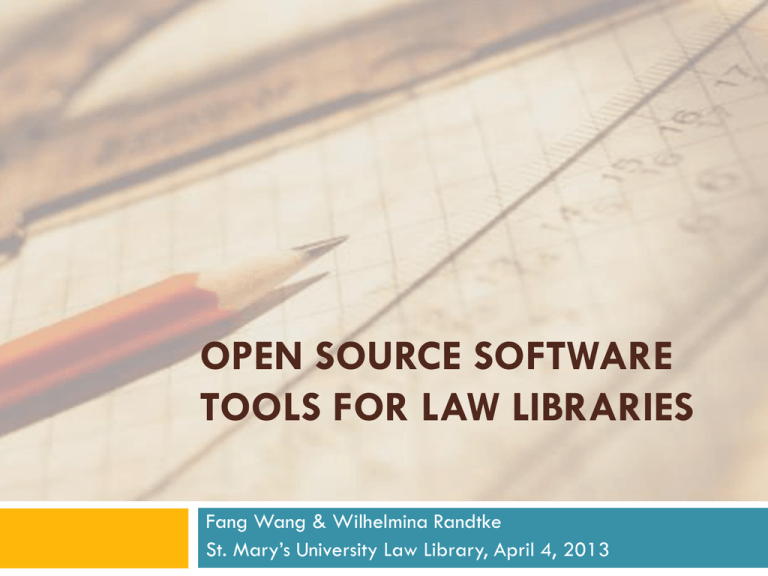
OPEN SOURCE SOFTWARE TOOLS FOR LAW LIBRARIES Fang Wang & Wilhelmina Randtke St. Mary’s University Law Library, April 4, 2013 What Is Open Source Software? Open source is a collaborative software development method that harnesses the power of peer review and transparency of process to develop code that is freely accessible. Open source software is software that users have the ability to use, distribute, study and modify for any purpose. Proprietary software Free software The Reality Economic crisis, budget cuts. The field of law is changing. Technology helps to prepare lawyers. The cost of technology tools is high. Law librarians are asked to do more with less. Adapt, incorporate, change. Why Open Source? Free or low cost No vendor lock-in User centric development Freedom to innovate Reliable through peer review Myths about Open Source “Open source is more risky because the project/software/community could just disappear!” “Open source must be less secure. Anyone could just add malicious code!” “If we go with open source, we won’t be able to get support!” Gartner Survey on Open Source Software Tools You Probably Know of Firefox OpenOffice VLC Tools You Might Not Know Content Management: Drupal, WordPress, Omeka Integrated Library System: Evergreen, Koha Course Management: Moodle Survey: Limesurvey Repository: DSpace, Eprints, Fedora Journal publishing: Open Journal Systems Image Editing: GIMP Operating System: Ubuntu …… Is Open Source Right for Me and My Law Library? Self-guided Readiness Assessment Survey: http://foss4lib.org/decision-support/control-versusresponsibility/online-interactive-version-survey Demos on Open Source Projects Open Source Projects at St. Mary’s law • Open source for web development • Open source applications Open source Desktop Applications at St. Mary’s Maps project: Making a map of the law library. Sound transfer: Going from tape to mp3 (for ILL requests) Maps Project: Image editing with GIMP Old Map: New Map: Old New Project Planning: Resources Microsoft Paint Project framework Multiple librarians (so, need to share files) A one hit project. Librarians rarely make a custom graphic. (We usually make posters with photographs.) What software would you use? Multiple licenses was key. Lets multiple librarians work on the project. Photoshop vs. GIMP Photoshop $160 per license at St. Mary’s, plus staff time to track and file license information centrally. Everyone on the project needs a license to be able to edit files. A learning curve. GIMP $0 per license; no need to manage licenses centrally. Can immediately install on any librarian’s computer. A learning curve. (similar to Photoshop) Photoshop Interface: Gimp Interface: Photoshop Interface: Stuff I have to learn Gimp Interface: Stuff I have to learn Training and Support Photoshop tutorials GIMP tutorials Maps Project: Image editing with GIMP Audio Tape Conversion: Audacity for ILL Texas Legislative materials Recordings of floor debates and committee hearings When you ILL material from the Texas Legislature, they will FedEx you an audio tape. …. an audiotape… Hipsters Professors Project Planning: Resources We borrowed a tape player from the main campus library. Project framework It is unreasonable to give an audio tape to a professor. Need to go from audiotape to mp3. Need to do this quickly (in days, not in weeks). What software would you use? For audio editing, there is a very clear open source product. The open source software is also the dominant product. Period. There also is no clear “go to” proprietary product. Sound Forge Pro at $325 a license is a solid pick. Audacity vs. Sound Forge Pro Audacity Can install it immediately; no purchase approval. $0 per license; no need to manage licenses centrally. Able to find instructions for what we needed to do (go from audiotape to mp3). Sound Forge Pro $325 per license; staff time to track the license for each install. Able to find instructions for what we needed to do. But, fewer instructions available. Training and Support Sound Forge Audacity Audio Tape Conversion: Audacity for ILL Open source Web Development at St. Mary’s Intranet Institutional Repository (both, and more, can run on the same server) Open source Platforms vs Applications Desktop Applications Same amount of time to learn how to use open source software. More documentation required for proprietary: Must track licenses for each install. Platforms Vendor run products are often very expensive. $1,000s per year. More technical skill is required to do your own. (Still some technical skill to configure a vendor’s product.) More documentation required for open source: Must keep configuration notes. Open source Platforms vs Applications Fewer hidden costs in proprietary platforms - CMSes, repository platforms, server stuff – (issues with server administration or troubleshooting). Main benefit of open source is you can get a service plan or consultant, and there is competition there. No vendor lock in with open source. Fewer hidden costs in open source desktop applications (issues with tracking licenses or finding install CDs 2 years later). Background on St. Mary’s University Small main campus School of Law = about 900 students and faculty Entire university (including the School of Law) = about 4,000 students and faculty Limited IT support Limited central resources (main campus is tiny) Private: Funded by student tuition Intranet: Quick file sharing in Drupal Simple place to keep documents and policies Goal = nothing lives in email Drupal one click install non technical Security issues: Can’t be used for truly confidential information Institutional Repository in Omeka Platform to display digital objects and share metadata OAI-PMH repository capabilities Omeka install Light server requirements Good for access Bad for preservation Cheap hosting: Comes with Open Source One-Click installs with cheap webhosting Open source: Free-as-in-puppy Things that get hard: Troubleshooting. How do I add this tiny little feature? Backups. How do I make a backup? You really have to understand the backend to do this right. Easy to make something quickly. Hard to ensure long term existence. Open source Web Development Pros No up front or ongoing money allocations for new projects (many projects can run on one server) Cons Can be free-as-in-puppy; can take significant staff time to set up and maintain. Security and backups are all in house; can be risky. Not enough technology skills in the law library community to quickly replace staff. Applications Servers Open source Platforms vs Applications Desktop Applications: Payoff for all Same amount of time to learn how to use open source software. More documentation required for proprietary: Must track licenses for each install. Platforms: Complex tradeoffs Vendor run products are often very expensive. $1,000s per year. Vendor lock-in is costly. More technical skill is required to do your own. (Still some technical skill to configure a vendor’s product.) More documentation required for open source: Must keep configuration notes. Open source Platforms vs Applications Fewer hidden costs in proprietary platforms - CMSes, repository platforms, server stuff – (issues with server administration or troubleshooting). Main benefit of open source is you can get a service plan or consultant, and there is competition there. No vendor lock in with open source. Fewer hidden costs in open source desktop applications (issues with tracking licenses or finding install CDs 2 years later). Any questions?
